Accounting and Finance for Managers: Soft Drink Company Analysis
VerifiedAdded on 2022/12/14
|16
|3667
|328
Report
AI Summary
This report provides a comprehensive financial analysis of three major soft drink companies: BARR (A.G.) PLC, BRITVIC PLC, and COCA-COLA EUROPEAN PARTNERS PLC. The analysis includes an examination of their strategic plans, financial performance over three years (2017-2020), and a critical evaluation using financial and non-financial ratios such as ROE, ROCE, profit margin, current ratio, and others. The report ranks the companies based on these metrics and justifies whether the top-performing company presents a positive investment opportunity. Furthermore, it explores various internal and external sources of long-term finance available to listed companies, with a specific focus on how a chosen finance source impacts stakeholder interests. The report concludes with an overview of the key findings and a list of references.

Accounting and Finance for Managers
Paraphrase This Document
Need a fresh take? Get an instant paraphrase of this document with our AI Paraphraser
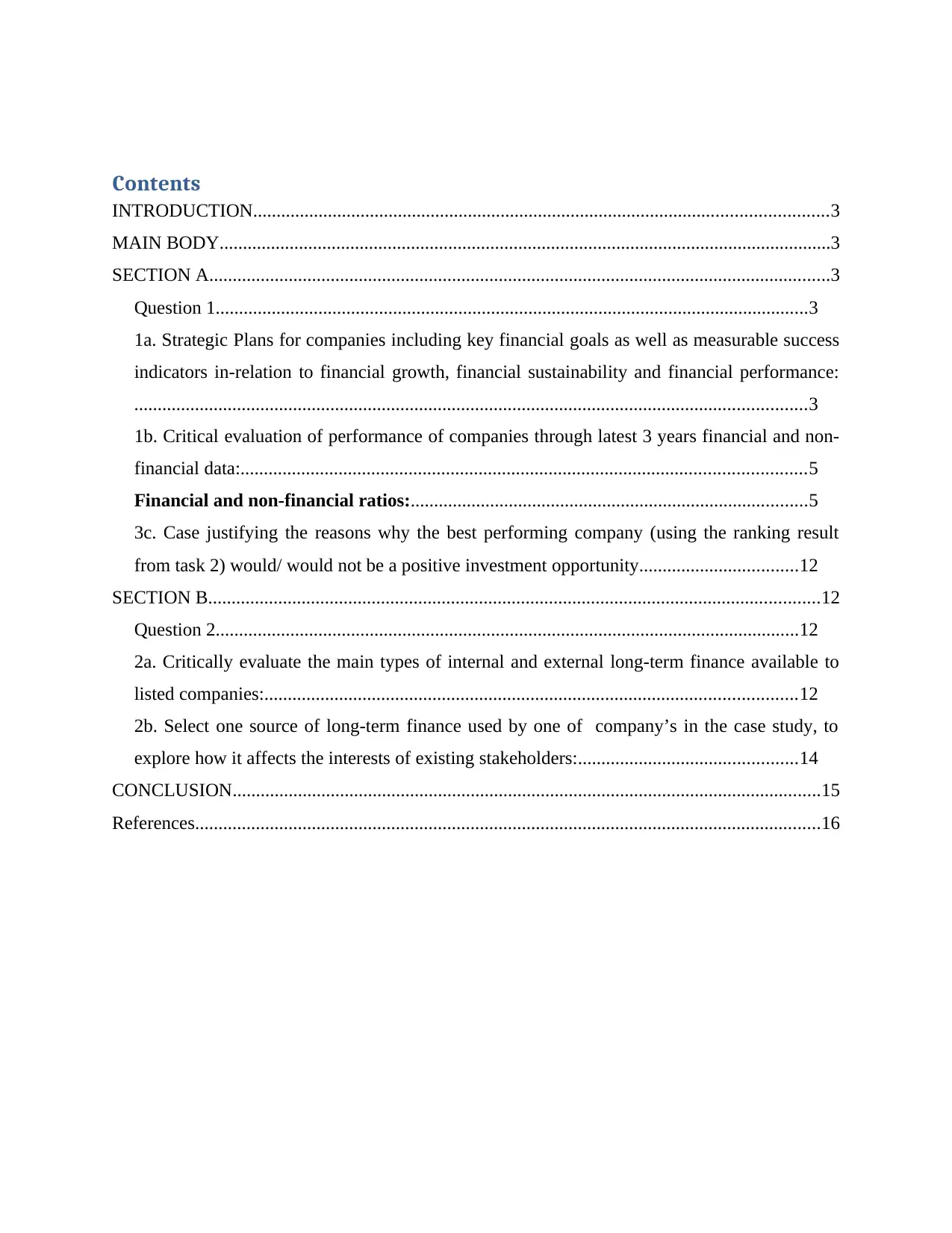
Contents
INTRODUCTION...........................................................................................................................3
MAIN BODY...................................................................................................................................3
SECTION A.....................................................................................................................................3
Question 1...............................................................................................................................3
1a. Strategic Plans for companies including key financial goals as well as measurable success
indicators in-relation to financial growth, financial sustainability and financial performance:
................................................................................................................................................3
1b. Critical evaluation of performance of companies through latest 3 years financial and non-
financial data:.........................................................................................................................5
Financial and non-financial ratios:.....................................................................................5
3c. Case justifying the reasons why the best performing company (using the ranking result
from task 2) would/ would not be a positive investment opportunity..................................12
SECTION B...................................................................................................................................12
Question 2.............................................................................................................................12
2a. Critically evaluate the main types of internal and external long-term finance available to
listed companies:..................................................................................................................12
2b. Select one source of long-term finance used by one of company’s in the case study, to
explore how it affects the interests of existing stakeholders:...............................................14
CONCLUSION..............................................................................................................................15
References......................................................................................................................................16
INTRODUCTION...........................................................................................................................3
MAIN BODY...................................................................................................................................3
SECTION A.....................................................................................................................................3
Question 1...............................................................................................................................3
1a. Strategic Plans for companies including key financial goals as well as measurable success
indicators in-relation to financial growth, financial sustainability and financial performance:
................................................................................................................................................3
1b. Critical evaluation of performance of companies through latest 3 years financial and non-
financial data:.........................................................................................................................5
Financial and non-financial ratios:.....................................................................................5
3c. Case justifying the reasons why the best performing company (using the ranking result
from task 2) would/ would not be a positive investment opportunity..................................12
SECTION B...................................................................................................................................12
Question 2.............................................................................................................................12
2a. Critically evaluate the main types of internal and external long-term finance available to
listed companies:..................................................................................................................12
2b. Select one source of long-term finance used by one of company’s in the case study, to
explore how it affects the interests of existing stakeholders:...............................................14
CONCLUSION..............................................................................................................................15
References......................................................................................................................................16
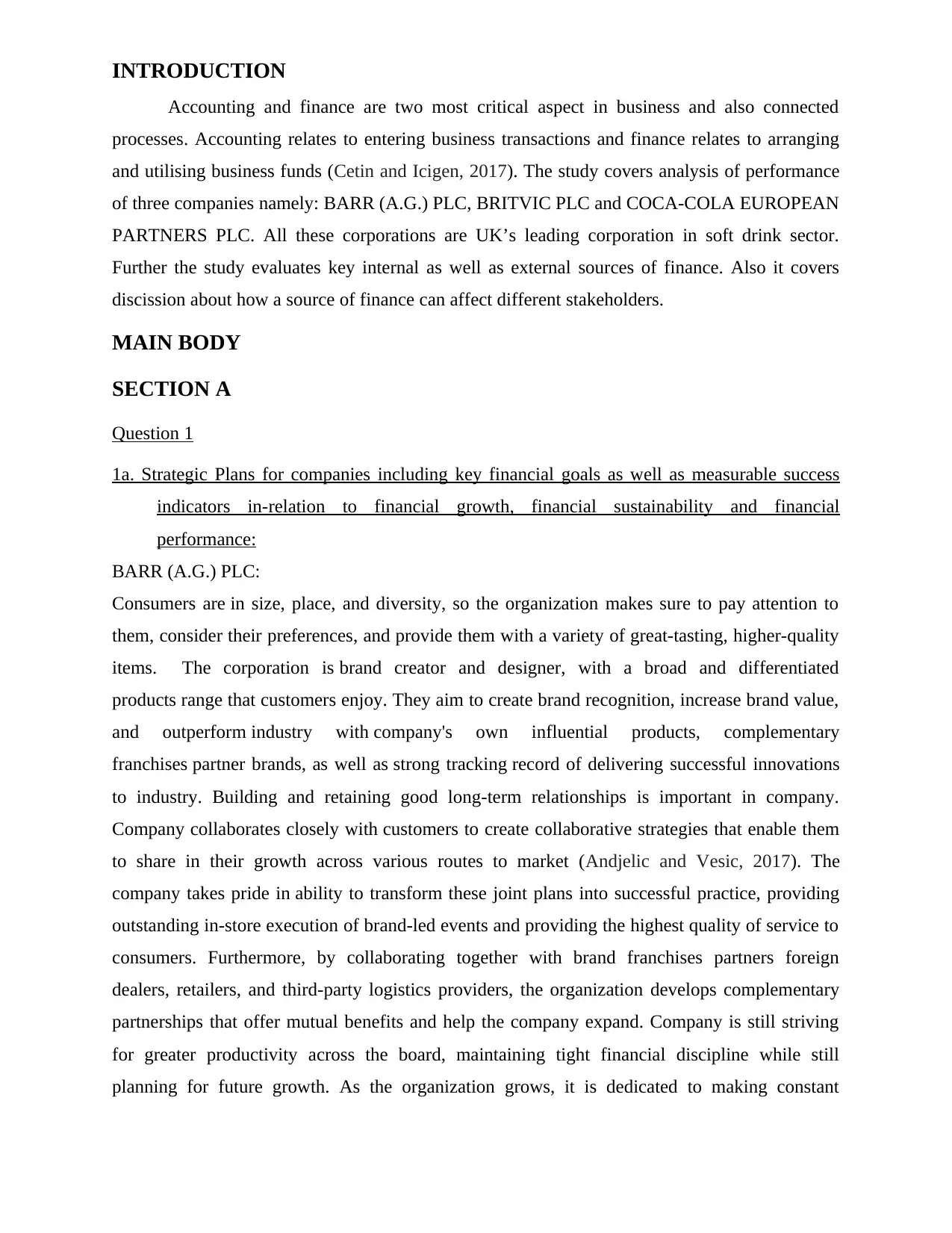
INTRODUCTION
Accounting and finance are two most critical aspect in business and also connected
processes. Accounting relates to entering business transactions and finance relates to arranging
and utilising business funds (Cetin and Icigen, 2017). The study covers analysis of performance
of three companies namely: BARR (A.G.) PLC, BRITVIC PLC and COCA-COLA EUROPEAN
PARTNERS PLC. All these corporations are UK’s leading corporation in soft drink sector.
Further the study evaluates key internal as well as external sources of finance. Also it covers
discission about how a source of finance can affect different stakeholders.
MAIN BODY
SECTION A
Question 1
1a. Strategic Plans for companies including key financial goals as well as measurable success
indicators in-relation to financial growth, financial sustainability and financial
performance:
BARR (A.G.) PLC:
Consumers are in size, place, and diversity, so the organization makes sure to pay attention to
them, consider their preferences, and provide them with a variety of great-tasting, higher-quality
items. The corporation is brand creator and designer, with a broad and differentiated
products range that customers enjoy. They aim to create brand recognition, increase brand value,
and outperform industry with company's own influential products, complementary
franchises partner brands, as well as strong tracking record of delivering successful innovations
to industry. Building and retaining good long-term relationships is important in company.
Company collaborates closely with customers to create collaborative strategies that enable them
to share in their growth across various routes to market (Andjelic and Vesic, 2017). The
company takes pride in ability to transform these joint plans into successful practice, providing
outstanding in-store execution of brand-led events and providing the highest quality of service to
consumers. Furthermore, by collaborating together with brand franchises partners foreign
dealers, retailers, and third-party logistics providers, the organization develops complementary
partnerships that offer mutual benefits and help the company expand. Company is still striving
for greater productivity across the board, maintaining tight financial discipline while still
planning for future growth. As the organization grows, it is dedicated to making constant
Accounting and finance are two most critical aspect in business and also connected
processes. Accounting relates to entering business transactions and finance relates to arranging
and utilising business funds (Cetin and Icigen, 2017). The study covers analysis of performance
of three companies namely: BARR (A.G.) PLC, BRITVIC PLC and COCA-COLA EUROPEAN
PARTNERS PLC. All these corporations are UK’s leading corporation in soft drink sector.
Further the study evaluates key internal as well as external sources of finance. Also it covers
discission about how a source of finance can affect different stakeholders.
MAIN BODY
SECTION A
Question 1
1a. Strategic Plans for companies including key financial goals as well as measurable success
indicators in-relation to financial growth, financial sustainability and financial
performance:
BARR (A.G.) PLC:
Consumers are in size, place, and diversity, so the organization makes sure to pay attention to
them, consider their preferences, and provide them with a variety of great-tasting, higher-quality
items. The corporation is brand creator and designer, with a broad and differentiated
products range that customers enjoy. They aim to create brand recognition, increase brand value,
and outperform industry with company's own influential products, complementary
franchises partner brands, as well as strong tracking record of delivering successful innovations
to industry. Building and retaining good long-term relationships is important in company.
Company collaborates closely with customers to create collaborative strategies that enable them
to share in their growth across various routes to market (Andjelic and Vesic, 2017). The
company takes pride in ability to transform these joint plans into successful practice, providing
outstanding in-store execution of brand-led events and providing the highest quality of service to
consumers. Furthermore, by collaborating together with brand franchises partners foreign
dealers, retailers, and third-party logistics providers, the organization develops complementary
partnerships that offer mutual benefits and help the company expand. Company is still striving
for greater productivity across the board, maintaining tight financial discipline while still
planning for future growth. As the organization grows, it is dedicated to making constant
⊘ This is a preview!⊘
Do you want full access?
Subscribe today to unlock all pages.

Trusted by 1+ million students worldwide
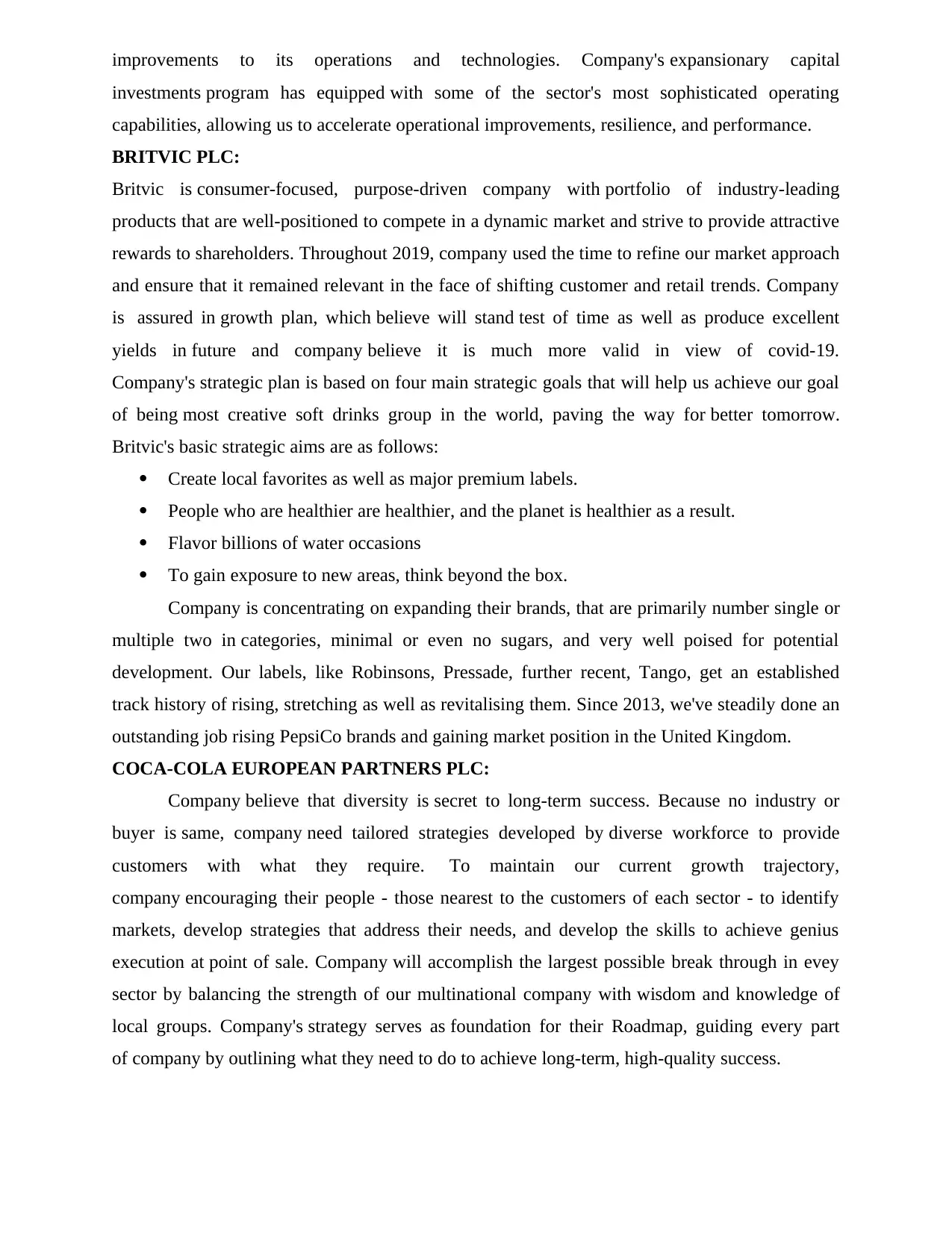
improvements to its operations and technologies. Company's expansionary capital
investments program has equipped with some of the sector's most sophisticated operating
capabilities, allowing us to accelerate operational improvements, resilience, and performance.
BRITVIC PLC:
Britvic is consumer-focused, purpose-driven company with portfolio of industry-leading
products that are well-positioned to compete in a dynamic market and strive to provide attractive
rewards to shareholders. Throughout 2019, company used the time to refine our market approach
and ensure that it remained relevant in the face of shifting customer and retail trends. Company
is assured in growth plan, which believe will stand test of time as well as produce excellent
yields in future and company believe it is much more valid in view of covid-19.
Company's strategic plan is based on four main strategic goals that will help us achieve our goal
of being most creative soft drinks group in the world, paving the way for better tomorrow.
Britvic's basic strategic aims are as follows:
Create local favorites as well as major premium labels.
People who are healthier are healthier, and the planet is healthier as a result.
Flavor billions of water occasions
To gain exposure to new areas, think beyond the box.
Company is concentrating on expanding their brands, that are primarily number single or
multiple two in categories, minimal or even no sugars, and very well poised for potential
development. Our labels, like Robinsons, Pressade, further recent, Tango, get an established
track history of rising, stretching as well as revitalising them. Since 2013, we've steadily done an
outstanding job rising PepsiCo brands and gaining market position in the United Kingdom.
COCA-COLA EUROPEAN PARTNERS PLC:
Company believe that diversity is secret to long-term success. Because no industry or
buyer is same, company need tailored strategies developed by diverse workforce to provide
customers with what they require. To maintain our current growth trajectory,
company encouraging their people - those nearest to the customers of each sector - to identify
markets, develop strategies that address their needs, and develop the skills to achieve genius
execution at point of sale. Company will accomplish the largest possible break through in evey
sector by balancing the strength of our multinational company with wisdom and knowledge of
local groups. Company's strategy serves as foundation for their Roadmap, guiding every part
of company by outlining what they need to do to achieve long-term, high-quality success.
investments program has equipped with some of the sector's most sophisticated operating
capabilities, allowing us to accelerate operational improvements, resilience, and performance.
BRITVIC PLC:
Britvic is consumer-focused, purpose-driven company with portfolio of industry-leading
products that are well-positioned to compete in a dynamic market and strive to provide attractive
rewards to shareholders. Throughout 2019, company used the time to refine our market approach
and ensure that it remained relevant in the face of shifting customer and retail trends. Company
is assured in growth plan, which believe will stand test of time as well as produce excellent
yields in future and company believe it is much more valid in view of covid-19.
Company's strategic plan is based on four main strategic goals that will help us achieve our goal
of being most creative soft drinks group in the world, paving the way for better tomorrow.
Britvic's basic strategic aims are as follows:
Create local favorites as well as major premium labels.
People who are healthier are healthier, and the planet is healthier as a result.
Flavor billions of water occasions
To gain exposure to new areas, think beyond the box.
Company is concentrating on expanding their brands, that are primarily number single or
multiple two in categories, minimal or even no sugars, and very well poised for potential
development. Our labels, like Robinsons, Pressade, further recent, Tango, get an established
track history of rising, stretching as well as revitalising them. Since 2013, we've steadily done an
outstanding job rising PepsiCo brands and gaining market position in the United Kingdom.
COCA-COLA EUROPEAN PARTNERS PLC:
Company believe that diversity is secret to long-term success. Because no industry or
buyer is same, company need tailored strategies developed by diverse workforce to provide
customers with what they require. To maintain our current growth trajectory,
company encouraging their people - those nearest to the customers of each sector - to identify
markets, develop strategies that address their needs, and develop the skills to achieve genius
execution at point of sale. Company will accomplish the largest possible break through in evey
sector by balancing the strength of our multinational company with wisdom and knowledge of
local groups. Company's strategy serves as foundation for their Roadmap, guiding every part
of company by outlining what they need to do to achieve long-term, high-quality success.
Paraphrase This Document
Need a fresh take? Get an instant paraphrase of this document with our AI Paraphraser
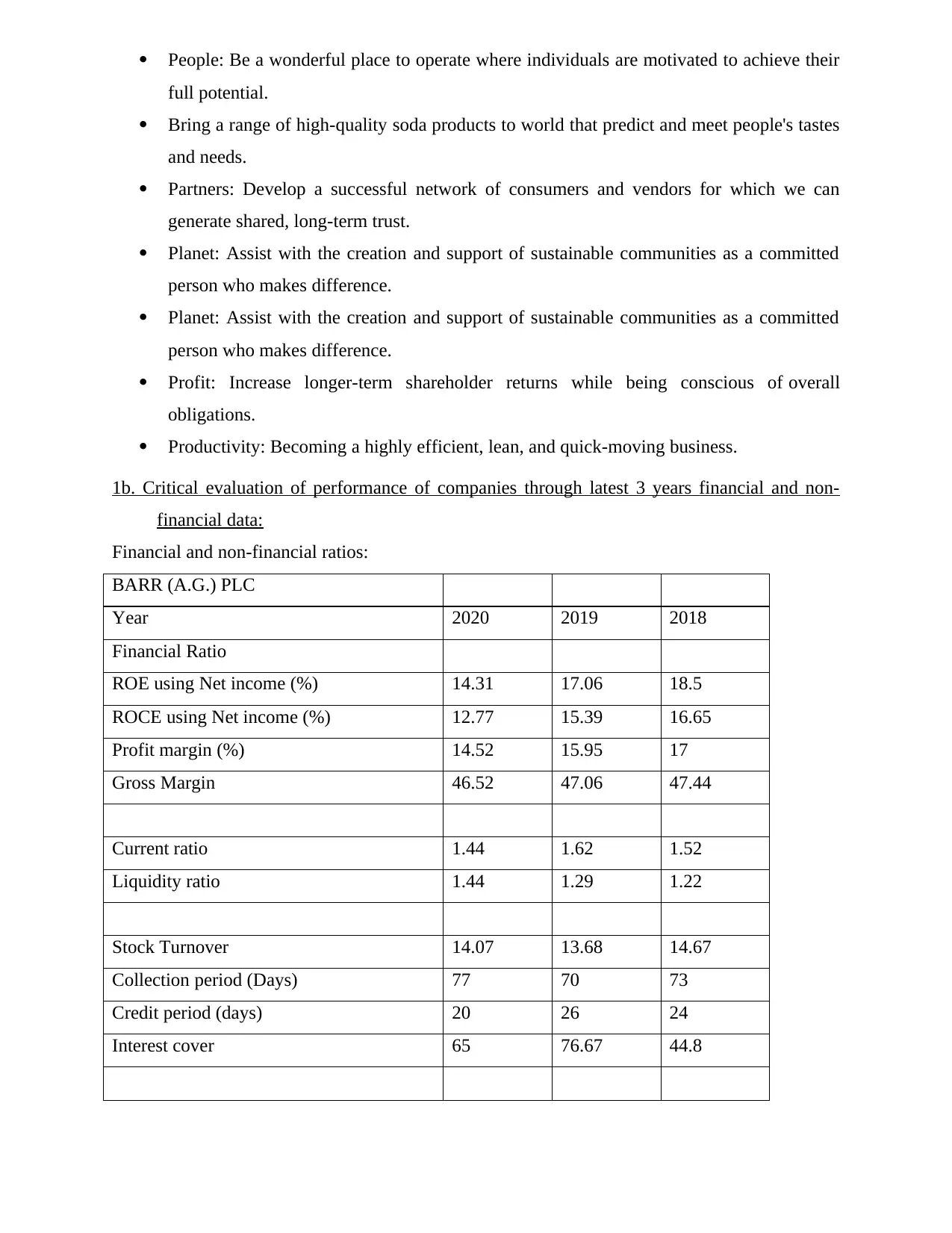
People: Be a wonderful place to operate where individuals are motivated to achieve their
full potential.
Bring a range of high-quality soda products to world that predict and meet people's tastes
and needs.
Partners: Develop a successful network of consumers and vendors for which we can
generate shared, long-term trust.
Planet: Assist with the creation and support of sustainable communities as a committed
person who makes difference.
Planet: Assist with the creation and support of sustainable communities as a committed
person who makes difference.
Profit: Increase longer-term shareholder returns while being conscious of overall
obligations.
Productivity: Becoming a highly efficient, lean, and quick-moving business.
1b. Critical evaluation of performance of companies through latest 3 years financial and non-
financial data:
Financial and non-financial ratios:
BARR (A.G.) PLC
Year 2020 2019 2018
Financial Ratio
ROE using Net income (%) 14.31 17.06 18.5
ROCE using Net income (%) 12.77 15.39 16.65
Profit margin (%) 14.52 15.95 17
Gross Margin 46.52 47.06 47.44
Current ratio 1.44 1.62 1.52
Liquidity ratio 1.44 1.29 1.22
Stock Turnover 14.07 13.68 14.67
Collection period (Days) 77 70 73
Credit period (days) 20 26 24
Interest cover 65 76.67 44.8
full potential.
Bring a range of high-quality soda products to world that predict and meet people's tastes
and needs.
Partners: Develop a successful network of consumers and vendors for which we can
generate shared, long-term trust.
Planet: Assist with the creation and support of sustainable communities as a committed
person who makes difference.
Planet: Assist with the creation and support of sustainable communities as a committed
person who makes difference.
Profit: Increase longer-term shareholder returns while being conscious of overall
obligations.
Productivity: Becoming a highly efficient, lean, and quick-moving business.
1b. Critical evaluation of performance of companies through latest 3 years financial and non-
financial data:
Financial and non-financial ratios:
BARR (A.G.) PLC
Year 2020 2019 2018
Financial Ratio
ROE using Net income (%) 14.31 17.06 18.5
ROCE using Net income (%) 12.77 15.39 16.65
Profit margin (%) 14.52 15.95 17
Gross Margin 46.52 47.06 47.44
Current ratio 1.44 1.62 1.52
Liquidity ratio 1.44 1.29 1.22
Stock Turnover 14.07 13.68 14.67
Collection period (Days) 77 70 73
Credit period (days) 20 26 24
Interest cover 65 76.67 44.8
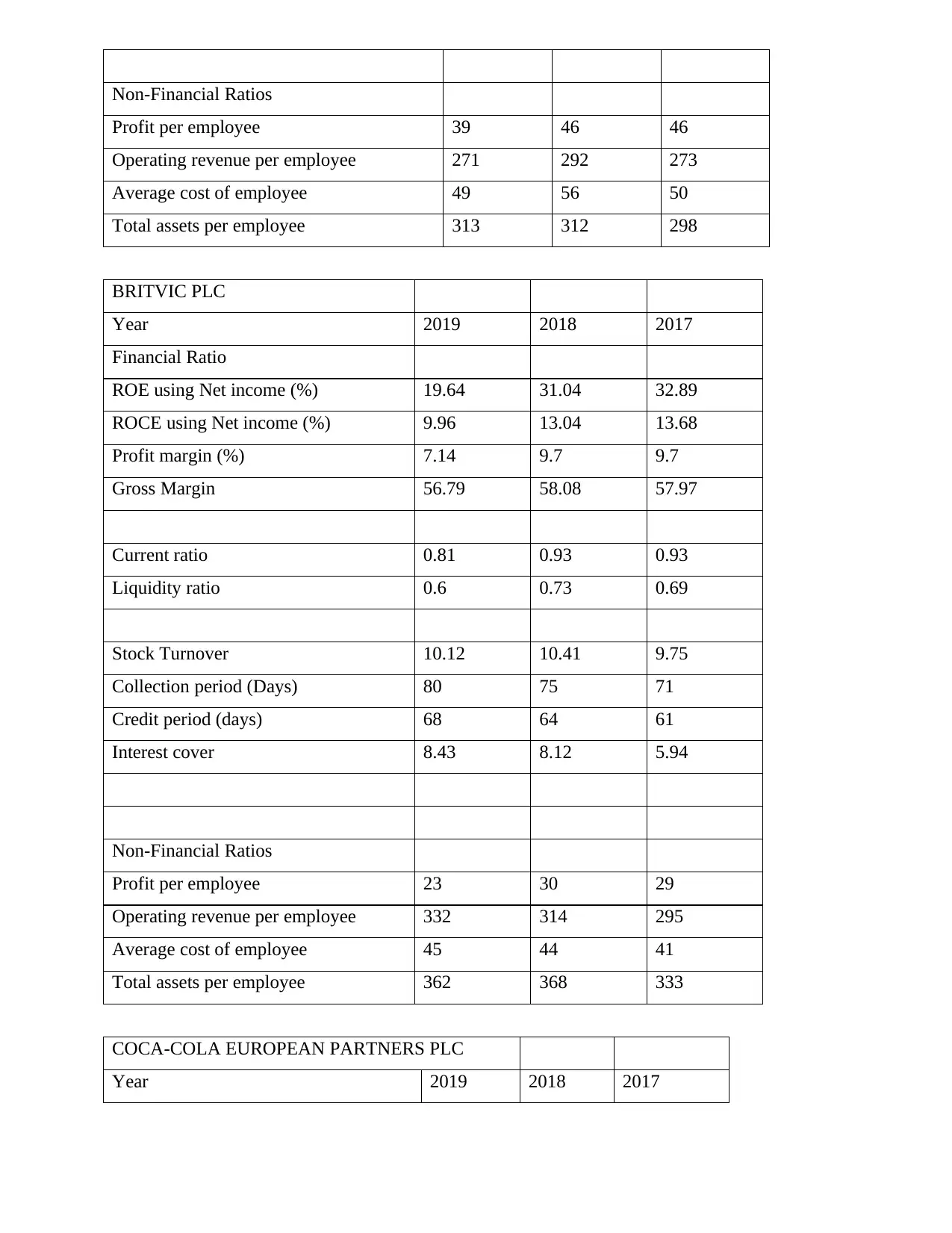
Non-Financial Ratios
Profit per employee 39 46 46
Operating revenue per employee 271 292 273
Average cost of employee 49 56 50
Total assets per employee 313 312 298
BRITVIC PLC
Year 2019 2018 2017
Financial Ratio
ROE using Net income (%) 19.64 31.04 32.89
ROCE using Net income (%) 9.96 13.04 13.68
Profit margin (%) 7.14 9.7 9.7
Gross Margin 56.79 58.08 57.97
Current ratio 0.81 0.93 0.93
Liquidity ratio 0.6 0.73 0.69
Stock Turnover 10.12 10.41 9.75
Collection period (Days) 80 75 71
Credit period (days) 68 64 61
Interest cover 8.43 8.12 5.94
Non-Financial Ratios
Profit per employee 23 30 29
Operating revenue per employee 332 314 295
Average cost of employee 45 44 41
Total assets per employee 362 368 333
COCA-COLA EUROPEAN PARTNERS PLC
Year 2019 2018 2017
Profit per employee 39 46 46
Operating revenue per employee 271 292 273
Average cost of employee 49 56 50
Total assets per employee 313 312 298
BRITVIC PLC
Year 2019 2018 2017
Financial Ratio
ROE using Net income (%) 19.64 31.04 32.89
ROCE using Net income (%) 9.96 13.04 13.68
Profit margin (%) 7.14 9.7 9.7
Gross Margin 56.79 58.08 57.97
Current ratio 0.81 0.93 0.93
Liquidity ratio 0.6 0.73 0.69
Stock Turnover 10.12 10.41 9.75
Collection period (Days) 80 75 71
Credit period (days) 68 64 61
Interest cover 8.43 8.12 5.94
Non-Financial Ratios
Profit per employee 23 30 29
Operating revenue per employee 332 314 295
Average cost of employee 45 44 41
Total assets per employee 362 368 333
COCA-COLA EUROPEAN PARTNERS PLC
Year 2019 2018 2017
⊘ This is a preview!⊘
Do you want full access?
Subscribe today to unlock all pages.

Trusted by 1+ million students worldwide
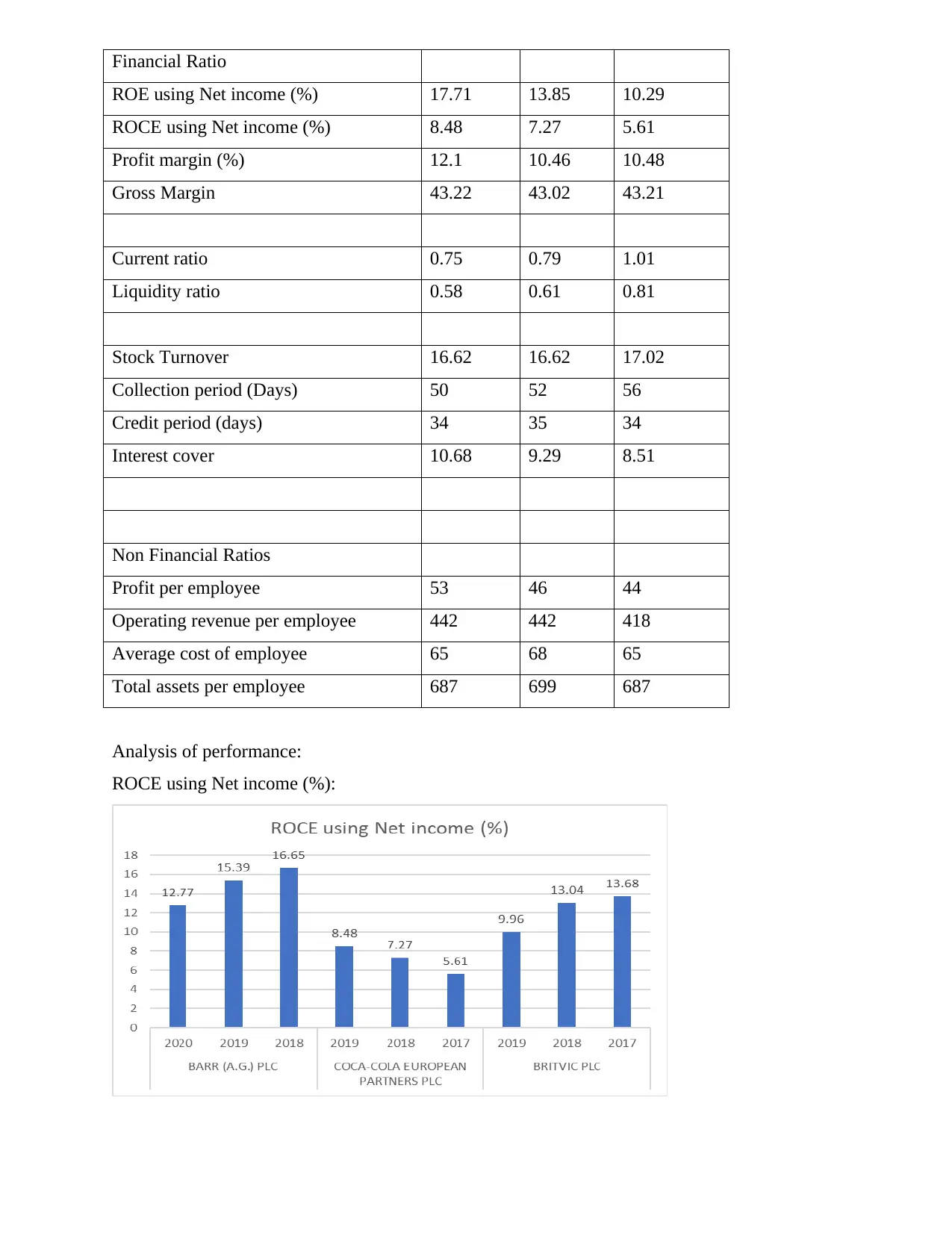
Financial Ratio
ROE using Net income (%) 17.71 13.85 10.29
ROCE using Net income (%) 8.48 7.27 5.61
Profit margin (%) 12.1 10.46 10.48
Gross Margin 43.22 43.02 43.21
Current ratio 0.75 0.79 1.01
Liquidity ratio 0.58 0.61 0.81
Stock Turnover 16.62 16.62 17.02
Collection period (Days) 50 52 56
Credit period (days) 34 35 34
Interest cover 10.68 9.29 8.51
Non Financial Ratios
Profit per employee 53 46 44
Operating revenue per employee 442 442 418
Average cost of employee 65 68 65
Total assets per employee 687 699 687
Analysis of performance:
ROCE using Net income (%):
ROE using Net income (%) 17.71 13.85 10.29
ROCE using Net income (%) 8.48 7.27 5.61
Profit margin (%) 12.1 10.46 10.48
Gross Margin 43.22 43.02 43.21
Current ratio 0.75 0.79 1.01
Liquidity ratio 0.58 0.61 0.81
Stock Turnover 16.62 16.62 17.02
Collection period (Days) 50 52 56
Credit period (days) 34 35 34
Interest cover 10.68 9.29 8.51
Non Financial Ratios
Profit per employee 53 46 44
Operating revenue per employee 442 442 418
Average cost of employee 65 68 65
Total assets per employee 687 699 687
Analysis of performance:
ROCE using Net income (%):
Paraphrase This Document
Need a fresh take? Get an instant paraphrase of this document with our AI Paraphraser
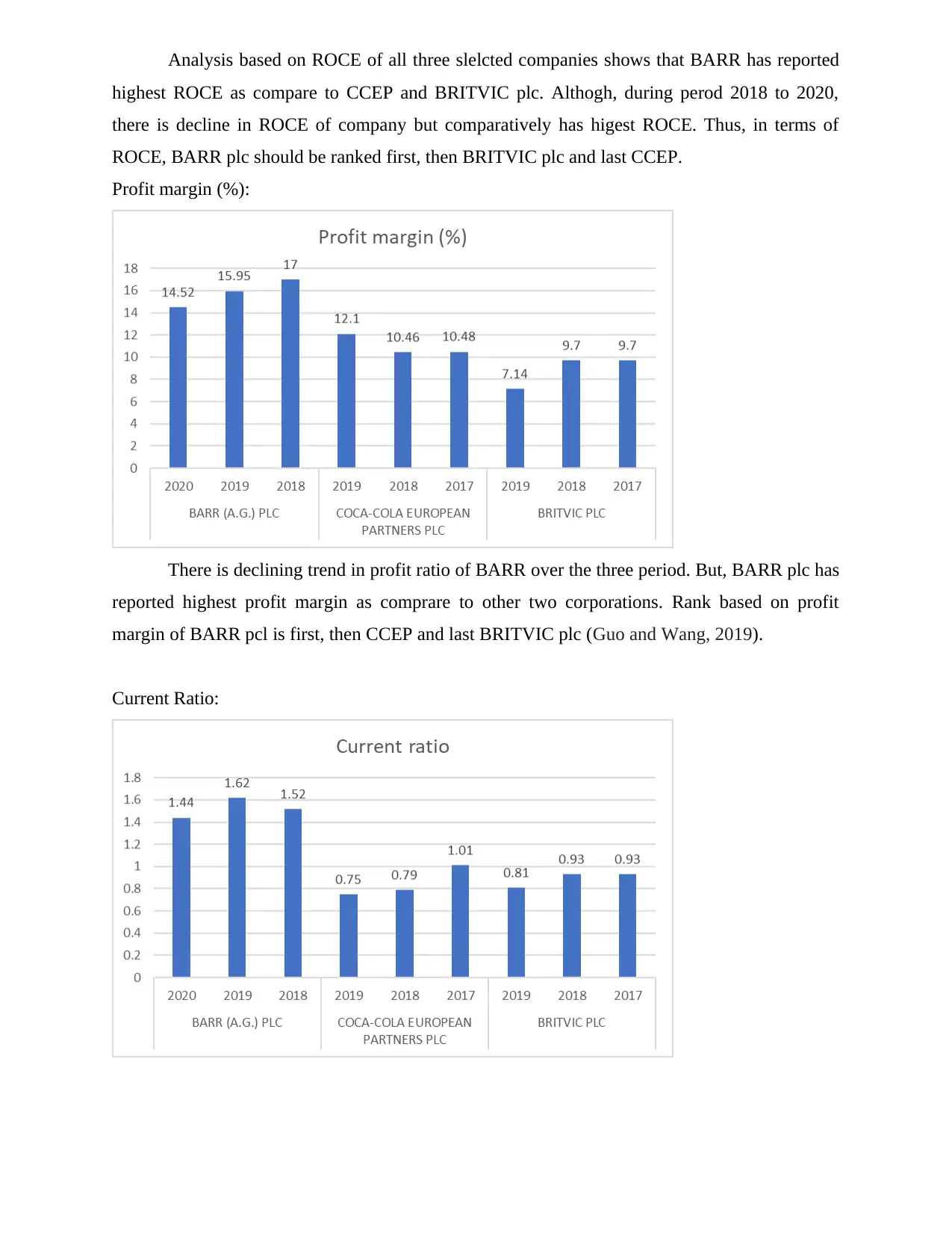
Analysis based on ROCE of all three slelcted companies shows that BARR has reported
highest ROCE as compare to CCEP and BRITVIC plc. Althogh, during perod 2018 to 2020,
there is decline in ROCE of company but comparatively has higest ROCE. Thus, in terms of
ROCE, BARR plc should be ranked first, then BRITVIC plc and last CCEP.
Profit margin (%):
There is declining trend in profit ratio of BARR over the three period. But, BARR plc has
reported highest profit margin as comprare to other two corporations. Rank based on profit
margin of BARR pcl is first, then CCEP and last BRITVIC plc (Guo and Wang, 2019).
Current Ratio:
highest ROCE as compare to CCEP and BRITVIC plc. Althogh, during perod 2018 to 2020,
there is decline in ROCE of company but comparatively has higest ROCE. Thus, in terms of
ROCE, BARR plc should be ranked first, then BRITVIC plc and last CCEP.
Profit margin (%):
There is declining trend in profit ratio of BARR over the three period. But, BARR plc has
reported highest profit margin as comprare to other two corporations. Rank based on profit
margin of BARR pcl is first, then CCEP and last BRITVIC plc (Guo and Wang, 2019).
Current Ratio:
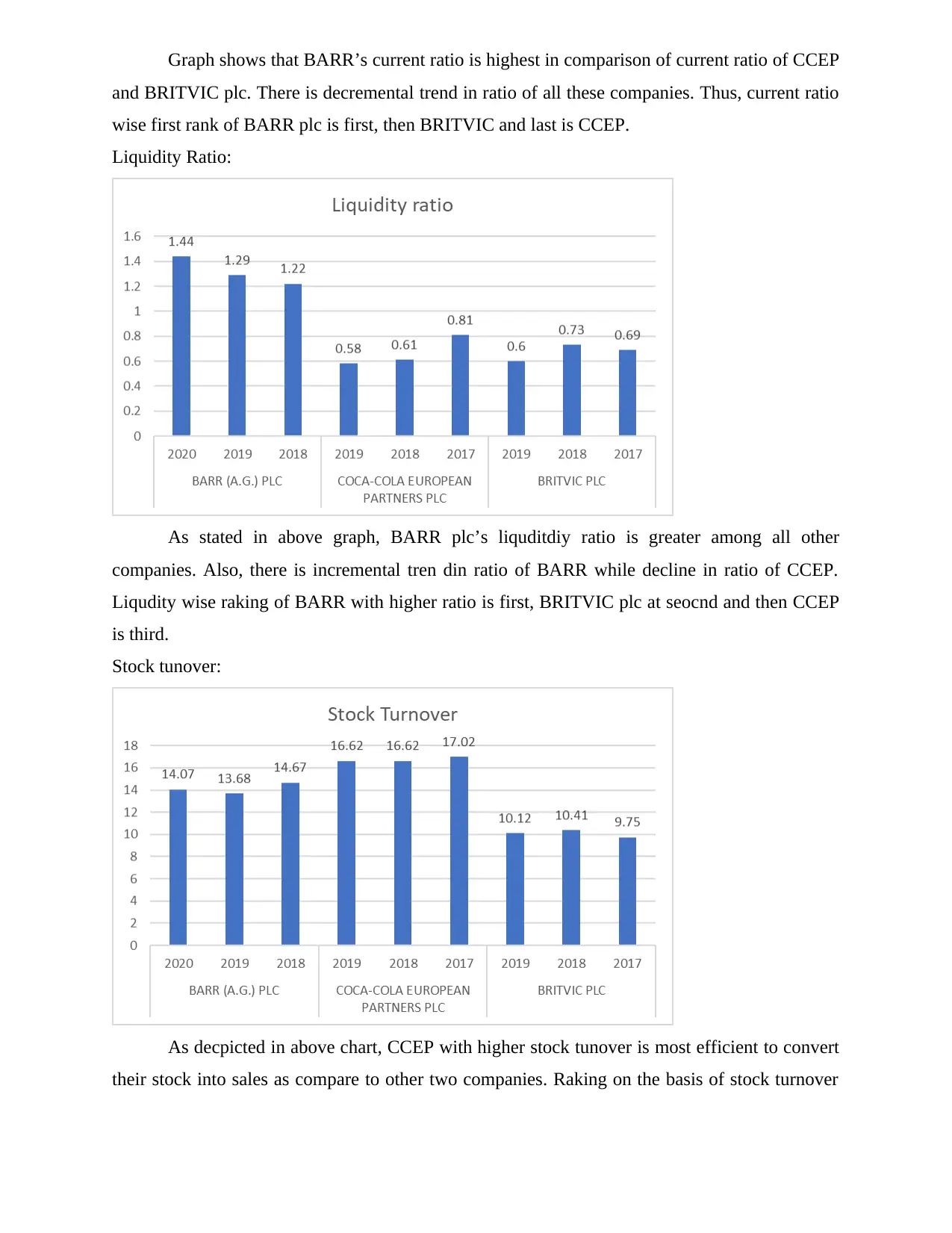
Graph shows that BARR’s current ratio is highest in comparison of current ratio of CCEP
and BRITVIC plc. There is decremental trend in ratio of all these companies. Thus, current ratio
wise first rank of BARR plc is first, then BRITVIC and last is CCEP.
Liquidity Ratio:
As stated in above graph, BARR plc’s liquditdiy ratio is greater among all other
companies. Also, there is incremental tren din ratio of BARR while decline in ratio of CCEP.
Liqudity wise raking of BARR with higher ratio is first, BRITVIC plc at seocnd and then CCEP
is third.
Stock tunover:
As decpicted in above chart, CCEP with higher stock tunover is most efficient to convert
their stock into sales as compare to other two companies. Raking on the basis of stock turnover
and BRITVIC plc. There is decremental trend in ratio of all these companies. Thus, current ratio
wise first rank of BARR plc is first, then BRITVIC and last is CCEP.
Liquidity Ratio:
As stated in above graph, BARR plc’s liquditdiy ratio is greater among all other
companies. Also, there is incremental tren din ratio of BARR while decline in ratio of CCEP.
Liqudity wise raking of BARR with higher ratio is first, BRITVIC plc at seocnd and then CCEP
is third.
Stock tunover:
As decpicted in above chart, CCEP with higher stock tunover is most efficient to convert
their stock into sales as compare to other two companies. Raking on the basis of stock turnover
⊘ This is a preview!⊘
Do you want full access?
Subscribe today to unlock all pages.

Trusted by 1+ million students worldwide
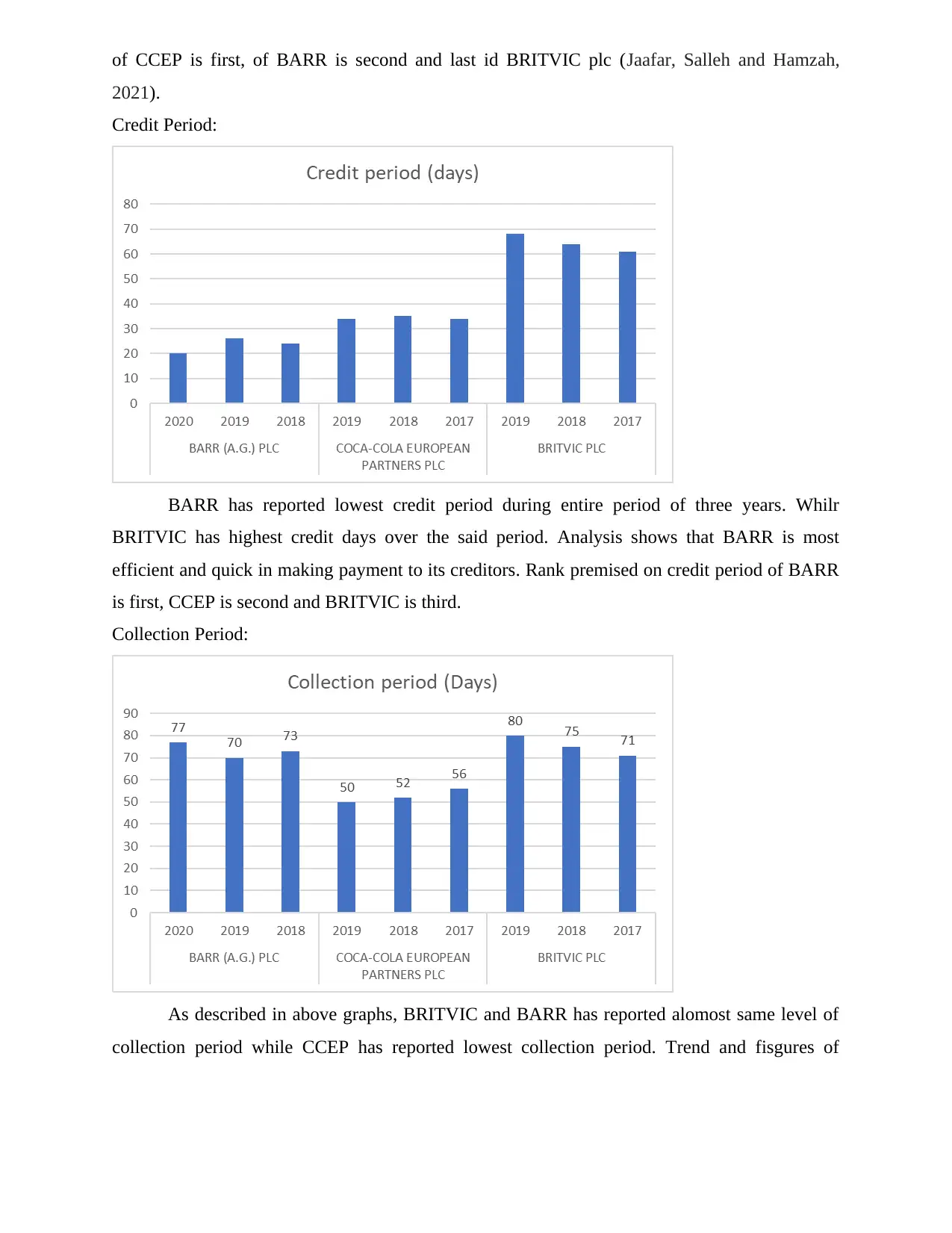
of CCEP is first, of BARR is second and last id BRITVIC plc (Jaafar, Salleh and Hamzah,
2021).
Credit Period:
BARR has reported lowest credit period during entire period of three years. Whilr
BRITVIC has highest credit days over the said period. Analysis shows that BARR is most
efficient and quick in making payment to its creditors. Rank premised on credit period of BARR
is first, CCEP is second and BRITVIC is third.
Collection Period:
As described in above graphs, BRITVIC and BARR has reported alomost same level of
collection period while CCEP has reported lowest collection period. Trend and fisgures of
2021).
Credit Period:
BARR has reported lowest credit period during entire period of three years. Whilr
BRITVIC has highest credit days over the said period. Analysis shows that BARR is most
efficient and quick in making payment to its creditors. Rank premised on credit period of BARR
is first, CCEP is second and BRITVIC is third.
Collection Period:
As described in above graphs, BRITVIC and BARR has reported alomost same level of
collection period while CCEP has reported lowest collection period. Trend and fisgures of
Paraphrase This Document
Need a fresh take? Get an instant paraphrase of this document with our AI Paraphraser
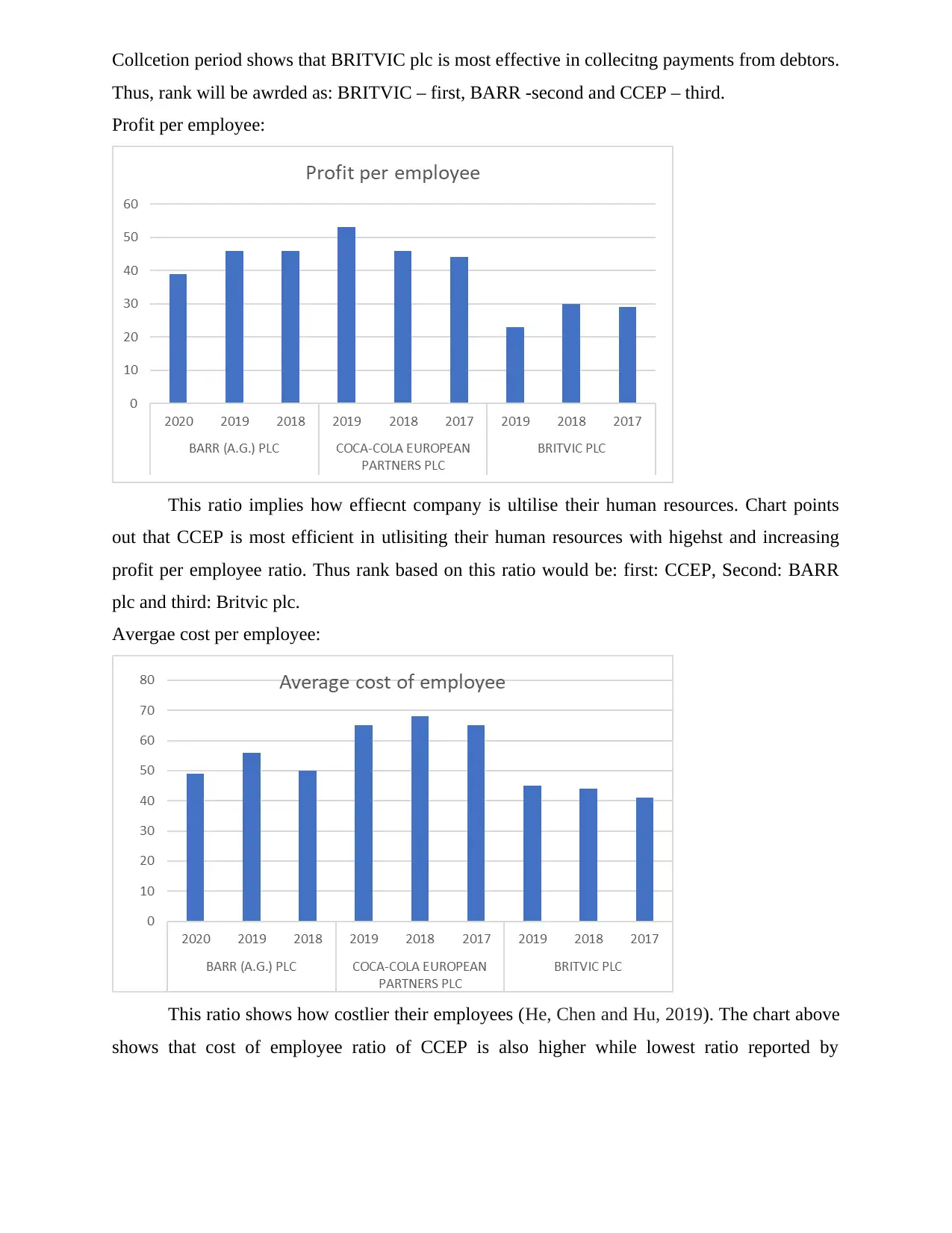
Collcetion period shows that BRITVIC plc is most effective in collecitng payments from debtors.
Thus, rank will be awrded as: BRITVIC – first, BARR -second and CCEP – third.
Profit per employee:
This ratio implies how effiecnt company is ultilise their human resources. Chart points
out that CCEP is most efficient in utlisiting their human resources with higehst and increasing
profit per employee ratio. Thus rank based on this ratio would be: first: CCEP, Second: BARR
plc and third: Britvic plc.
Avergae cost per employee:
This ratio shows how costlier their employees (He, Chen and Hu, 2019). The chart above
shows that cost of employee ratio of CCEP is also higher while lowest ratio reported by
Thus, rank will be awrded as: BRITVIC – first, BARR -second and CCEP – third.
Profit per employee:
This ratio implies how effiecnt company is ultilise their human resources. Chart points
out that CCEP is most efficient in utlisiting their human resources with higehst and increasing
profit per employee ratio. Thus rank based on this ratio would be: first: CCEP, Second: BARR
plc and third: Britvic plc.
Avergae cost per employee:
This ratio shows how costlier their employees (He, Chen and Hu, 2019). The chart above
shows that cost of employee ratio of CCEP is also higher while lowest ratio reported by
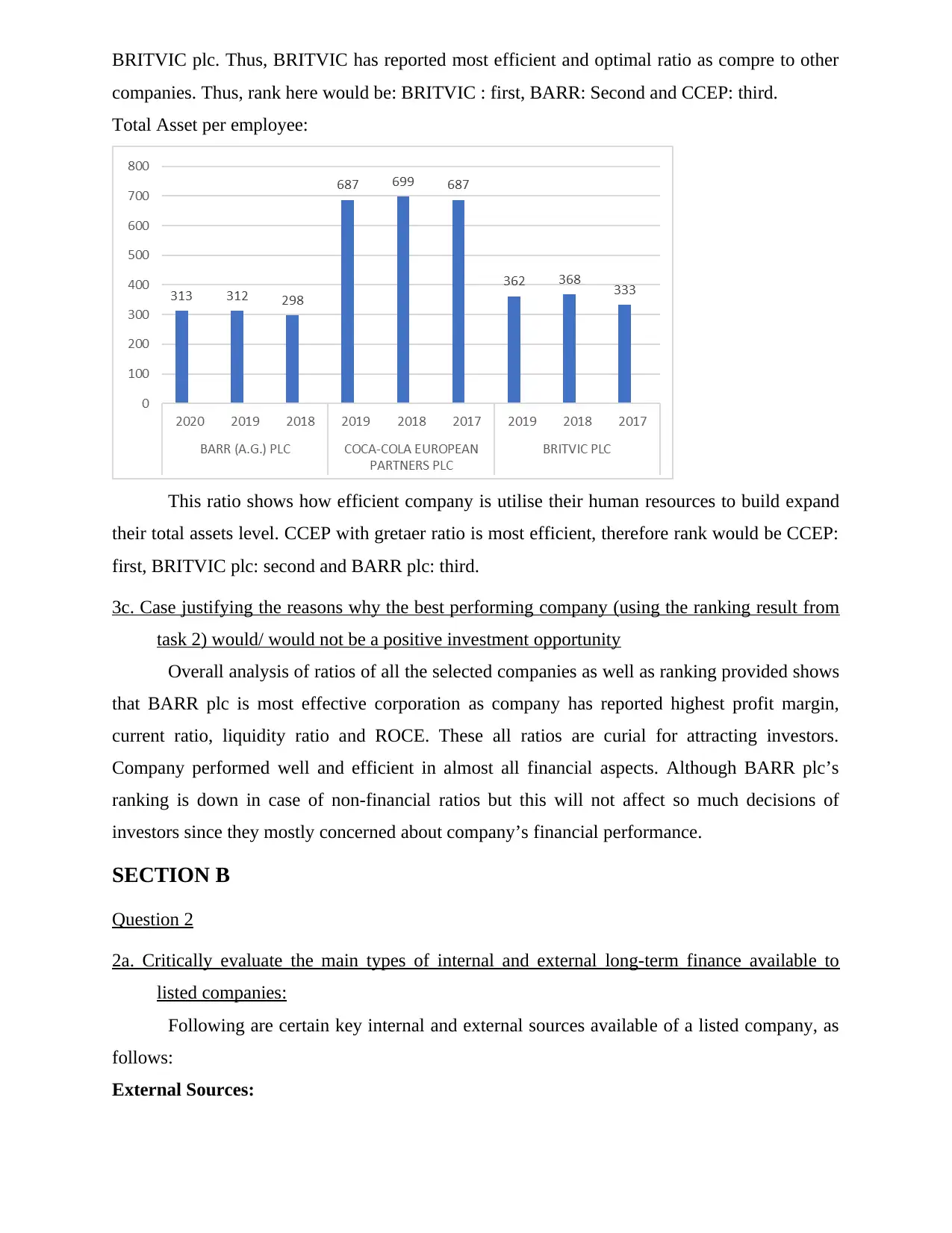
BRITVIC plc. Thus, BRITVIC has reported most efficient and optimal ratio as compre to other
companies. Thus, rank here would be: BRITVIC : first, BARR: Second and CCEP: third.
Total Asset per employee:
This ratio shows how efficient company is utilise their human resources to build expand
their total assets level. CCEP with gretaer ratio is most efficient, therefore rank would be CCEP:
first, BRITVIC plc: second and BARR plc: third.
3c. Case justifying the reasons why the best performing company (using the ranking result from
task 2) would/ would not be a positive investment opportunity
Overall analysis of ratios of all the selected companies as well as ranking provided shows
that BARR plc is most effective corporation as company has reported highest profit margin,
current ratio, liquidity ratio and ROCE. These all ratios are curial for attracting investors.
Company performed well and efficient in almost all financial aspects. Although BARR plc’s
ranking is down in case of non-financial ratios but this will not affect so much decisions of
investors since they mostly concerned about company’s financial performance.
SECTION B
Question 2
2a. Critically evaluate the main types of internal and external long-term finance available to
listed companies:
Following are certain key internal and external sources available of a listed company, as
follows:
External Sources:
companies. Thus, rank here would be: BRITVIC : first, BARR: Second and CCEP: third.
Total Asset per employee:
This ratio shows how efficient company is utilise their human resources to build expand
their total assets level. CCEP with gretaer ratio is most efficient, therefore rank would be CCEP:
first, BRITVIC plc: second and BARR plc: third.
3c. Case justifying the reasons why the best performing company (using the ranking result from
task 2) would/ would not be a positive investment opportunity
Overall analysis of ratios of all the selected companies as well as ranking provided shows
that BARR plc is most effective corporation as company has reported highest profit margin,
current ratio, liquidity ratio and ROCE. These all ratios are curial for attracting investors.
Company performed well and efficient in almost all financial aspects. Although BARR plc’s
ranking is down in case of non-financial ratios but this will not affect so much decisions of
investors since they mostly concerned about company’s financial performance.
SECTION B
Question 2
2a. Critically evaluate the main types of internal and external long-term finance available to
listed companies:
Following are certain key internal and external sources available of a listed company, as
follows:
External Sources:
⊘ This is a preview!⊘
Do you want full access?
Subscribe today to unlock all pages.

Trusted by 1+ million students worldwide
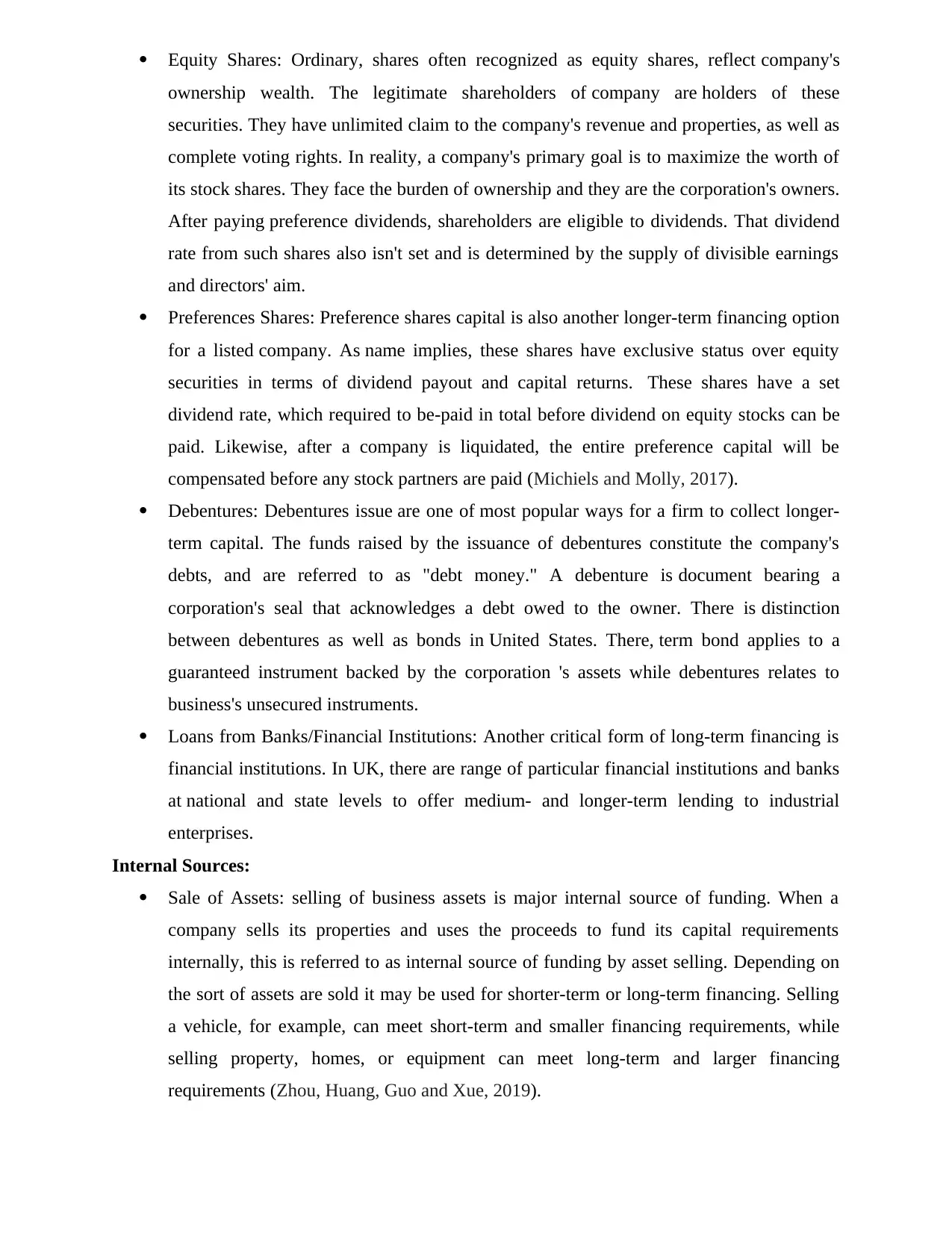
Equity Shares: Ordinary, shares often recognized as equity shares, reflect company's
ownership wealth. The legitimate shareholders of company are holders of these
securities. They have unlimited claim to the company's revenue and properties, as well as
complete voting rights. In reality, a company's primary goal is to maximize the worth of
its stock shares. They face the burden of ownership and they are the corporation's owners.
After paying preference dividends, shareholders are eligible to dividends. That dividend
rate from such shares also isn't set and is determined by the supply of divisible earnings
and directors' aim.
Preferences Shares: Preference shares capital is also another longer-term financing option
for a listed company. As name implies, these shares have exclusive status over equity
securities in terms of dividend payout and capital returns. These shares have a set
dividend rate, which required to be-paid in total before dividend on equity stocks can be
paid. Likewise, after a company is liquidated, the entire preference capital will be
compensated before any stock partners are paid (Michiels and Molly, 2017).
Debentures: Debentures issue are one of most popular ways for a firm to collect longer-
term capital. The funds raised by the issuance of debentures constitute the company's
debts, and are referred to as "debt money." A debenture is document bearing a
corporation's seal that acknowledges a debt owed to the owner. There is distinction
between debentures as well as bonds in United States. There, term bond applies to a
guaranteed instrument backed by the corporation 's assets while debentures relates to
business's unsecured instruments.
Loans from Banks/Financial Institutions: Another critical form of long-term financing is
financial institutions. In UK, there are range of particular financial institutions and banks
at national and state levels to offer medium- and longer-term lending to industrial
enterprises.
Internal Sources:
Sale of Assets: selling of business assets is major internal source of funding. When a
company sells its properties and uses the proceeds to fund its capital requirements
internally, this is referred to as internal source of funding by asset selling. Depending on
the sort of assets are sold it may be used for shorter-term or long-term financing. Selling
a vehicle, for example, can meet short-term and smaller financing requirements, while
selling property, homes, or equipment can meet long-term and larger financing
requirements (Zhou, Huang, Guo and Xue, 2019).
ownership wealth. The legitimate shareholders of company are holders of these
securities. They have unlimited claim to the company's revenue and properties, as well as
complete voting rights. In reality, a company's primary goal is to maximize the worth of
its stock shares. They face the burden of ownership and they are the corporation's owners.
After paying preference dividends, shareholders are eligible to dividends. That dividend
rate from such shares also isn't set and is determined by the supply of divisible earnings
and directors' aim.
Preferences Shares: Preference shares capital is also another longer-term financing option
for a listed company. As name implies, these shares have exclusive status over equity
securities in terms of dividend payout and capital returns. These shares have a set
dividend rate, which required to be-paid in total before dividend on equity stocks can be
paid. Likewise, after a company is liquidated, the entire preference capital will be
compensated before any stock partners are paid (Michiels and Molly, 2017).
Debentures: Debentures issue are one of most popular ways for a firm to collect longer-
term capital. The funds raised by the issuance of debentures constitute the company's
debts, and are referred to as "debt money." A debenture is document bearing a
corporation's seal that acknowledges a debt owed to the owner. There is distinction
between debentures as well as bonds in United States. There, term bond applies to a
guaranteed instrument backed by the corporation 's assets while debentures relates to
business's unsecured instruments.
Loans from Banks/Financial Institutions: Another critical form of long-term financing is
financial institutions. In UK, there are range of particular financial institutions and banks
at national and state levels to offer medium- and longer-term lending to industrial
enterprises.
Internal Sources:
Sale of Assets: selling of business assets is major internal source of funding. When a
company sells its properties and uses the proceeds to fund its capital requirements
internally, this is referred to as internal source of funding by asset selling. Depending on
the sort of assets are sold it may be used for shorter-term or long-term financing. Selling
a vehicle, for example, can meet short-term and smaller financing requirements, while
selling property, homes, or equipment can meet long-term and larger financing
requirements (Zhou, Huang, Guo and Xue, 2019).
Paraphrase This Document
Need a fresh take? Get an instant paraphrase of this document with our AI Paraphraser
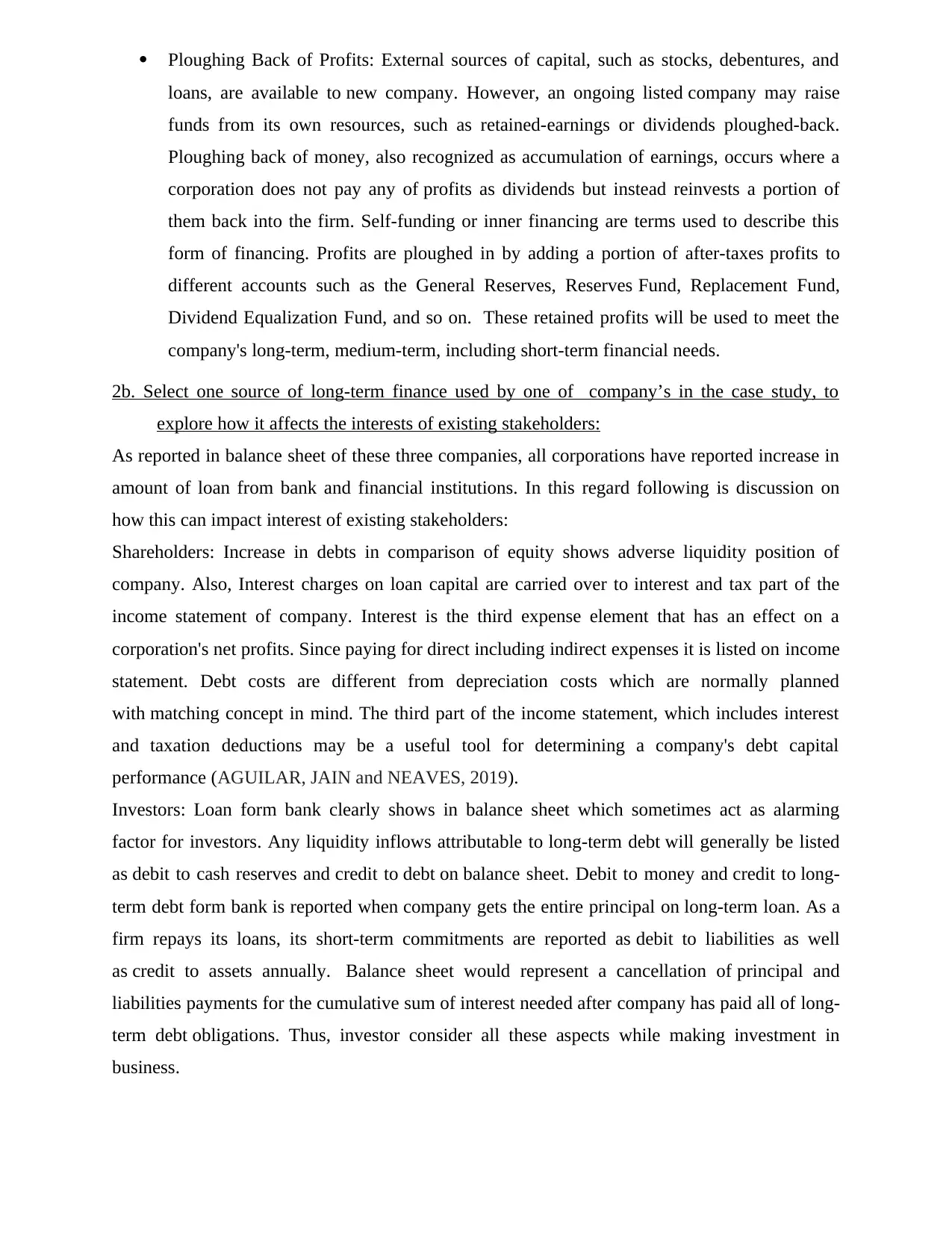
Ploughing Back of Profits: External sources of capital, such as stocks, debentures, and
loans, are available to new company. However, an ongoing listed company may raise
funds from its own resources, such as retained-earnings or dividends ploughed-back.
Ploughing back of money, also recognized as accumulation of earnings, occurs where a
corporation does not pay any of profits as dividends but instead reinvests a portion of
them back into the firm. Self-funding or inner financing are terms used to describe this
form of financing. Profits are ploughed in by adding a portion of after-taxes profits to
different accounts such as the General Reserves, Reserves Fund, Replacement Fund,
Dividend Equalization Fund, and so on. These retained profits will be used to meet the
company's long-term, medium-term, including short-term financial needs.
2b. Select one source of long-term finance used by one of company’s in the case study, to
explore how it affects the interests of existing stakeholders:
As reported in balance sheet of these three companies, all corporations have reported increase in
amount of loan from bank and financial institutions. In this regard following is discussion on
how this can impact interest of existing stakeholders:
Shareholders: Increase in debts in comparison of equity shows adverse liquidity position of
company. Also, Interest charges on loan capital are carried over to interest and tax part of the
income statement of company. Interest is the third expense element that has an effect on a
corporation's net profits. Since paying for direct including indirect expenses it is listed on income
statement. Debt costs are different from depreciation costs which are normally planned
with matching concept in mind. The third part of the income statement, which includes interest
and taxation deductions may be a useful tool for determining a company's debt capital
performance (AGUILAR, JAIN and NEAVES, 2019).
Investors: Loan form bank clearly shows in balance sheet which sometimes act as alarming
factor for investors. Any liquidity inflows attributable to long-term debt will generally be listed
as debit to cash reserves and credit to debt on balance sheet. Debit to money and credit to long-
term debt form bank is reported when company gets the entire principal on long-term loan. As a
firm repays its loans, its short-term commitments are reported as debit to liabilities as well
as credit to assets annually. Balance sheet would represent a cancellation of principal and
liabilities payments for the cumulative sum of interest needed after company has paid all of long-
term debt obligations. Thus, investor consider all these aspects while making investment in
business.
loans, are available to new company. However, an ongoing listed company may raise
funds from its own resources, such as retained-earnings or dividends ploughed-back.
Ploughing back of money, also recognized as accumulation of earnings, occurs where a
corporation does not pay any of profits as dividends but instead reinvests a portion of
them back into the firm. Self-funding or inner financing are terms used to describe this
form of financing. Profits are ploughed in by adding a portion of after-taxes profits to
different accounts such as the General Reserves, Reserves Fund, Replacement Fund,
Dividend Equalization Fund, and so on. These retained profits will be used to meet the
company's long-term, medium-term, including short-term financial needs.
2b. Select one source of long-term finance used by one of company’s in the case study, to
explore how it affects the interests of existing stakeholders:
As reported in balance sheet of these three companies, all corporations have reported increase in
amount of loan from bank and financial institutions. In this regard following is discussion on
how this can impact interest of existing stakeholders:
Shareholders: Increase in debts in comparison of equity shows adverse liquidity position of
company. Also, Interest charges on loan capital are carried over to interest and tax part of the
income statement of company. Interest is the third expense element that has an effect on a
corporation's net profits. Since paying for direct including indirect expenses it is listed on income
statement. Debt costs are different from depreciation costs which are normally planned
with matching concept in mind. The third part of the income statement, which includes interest
and taxation deductions may be a useful tool for determining a company's debt capital
performance (AGUILAR, JAIN and NEAVES, 2019).
Investors: Loan form bank clearly shows in balance sheet which sometimes act as alarming
factor for investors. Any liquidity inflows attributable to long-term debt will generally be listed
as debit to cash reserves and credit to debt on balance sheet. Debit to money and credit to long-
term debt form bank is reported when company gets the entire principal on long-term loan. As a
firm repays its loans, its short-term commitments are reported as debit to liabilities as well
as credit to assets annually. Balance sheet would represent a cancellation of principal and
liabilities payments for the cumulative sum of interest needed after company has paid all of long-
term debt obligations. Thus, investor consider all these aspects while making investment in
business.
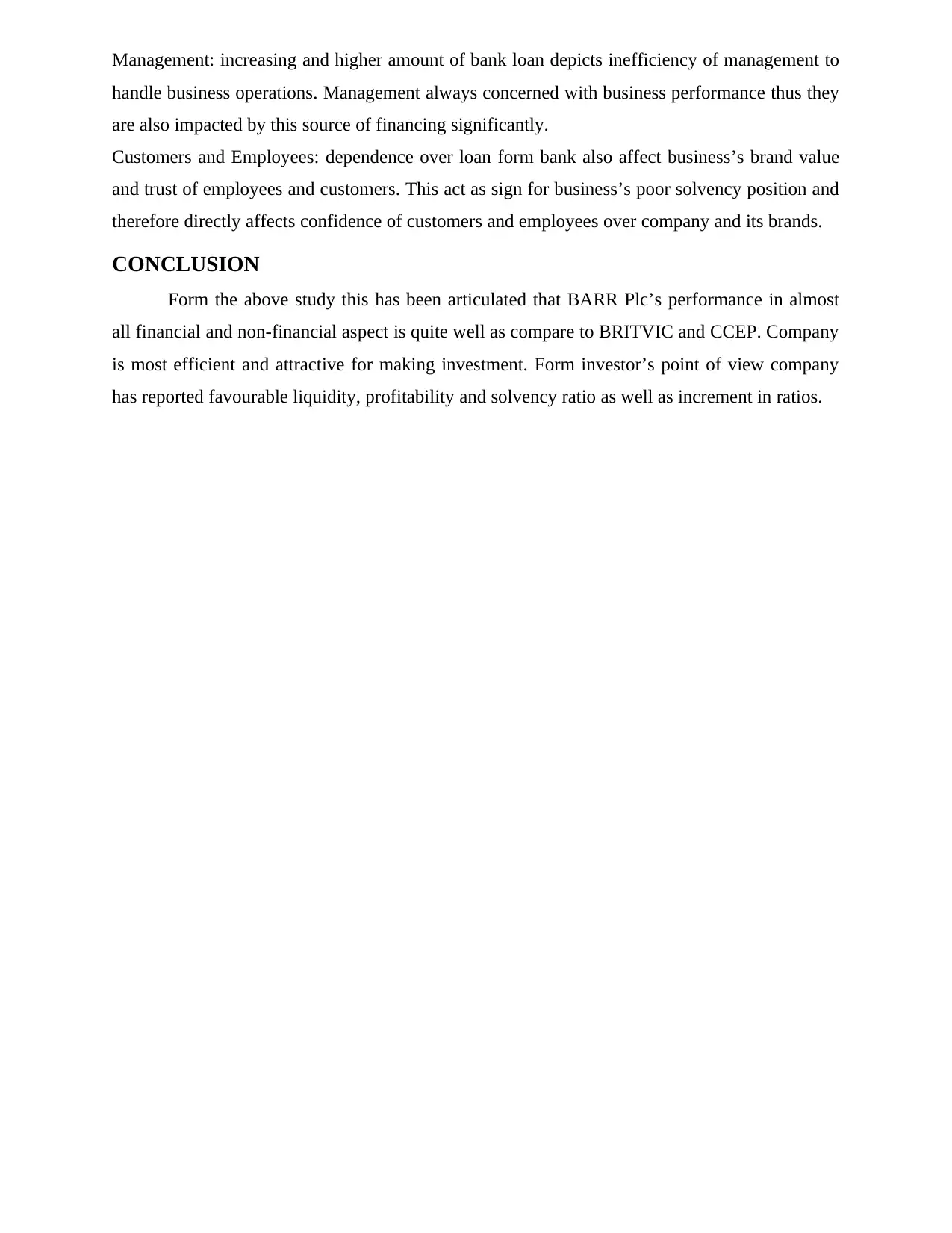
Management: increasing and higher amount of bank loan depicts inefficiency of management to
handle business operations. Management always concerned with business performance thus they
are also impacted by this source of financing significantly.
Customers and Employees: dependence over loan form bank also affect business’s brand value
and trust of employees and customers. This act as sign for business’s poor solvency position and
therefore directly affects confidence of customers and employees over company and its brands.
CONCLUSION
Form the above study this has been articulated that BARR Plc’s performance in almost
all financial and non-financial aspect is quite well as compare to BRITVIC and CCEP. Company
is most efficient and attractive for making investment. Form investor’s point of view company
has reported favourable liquidity, profitability and solvency ratio as well as increment in ratios.
handle business operations. Management always concerned with business performance thus they
are also impacted by this source of financing significantly.
Customers and Employees: dependence over loan form bank also affect business’s brand value
and trust of employees and customers. This act as sign for business’s poor solvency position and
therefore directly affects confidence of customers and employees over company and its brands.
CONCLUSION
Form the above study this has been articulated that BARR Plc’s performance in almost
all financial and non-financial aspect is quite well as compare to BRITVIC and CCEP. Company
is most efficient and attractive for making investment. Form investor’s point of view company
has reported favourable liquidity, profitability and solvency ratio as well as increment in ratios.
⊘ This is a preview!⊘
Do you want full access?
Subscribe today to unlock all pages.

Trusted by 1+ million students worldwide
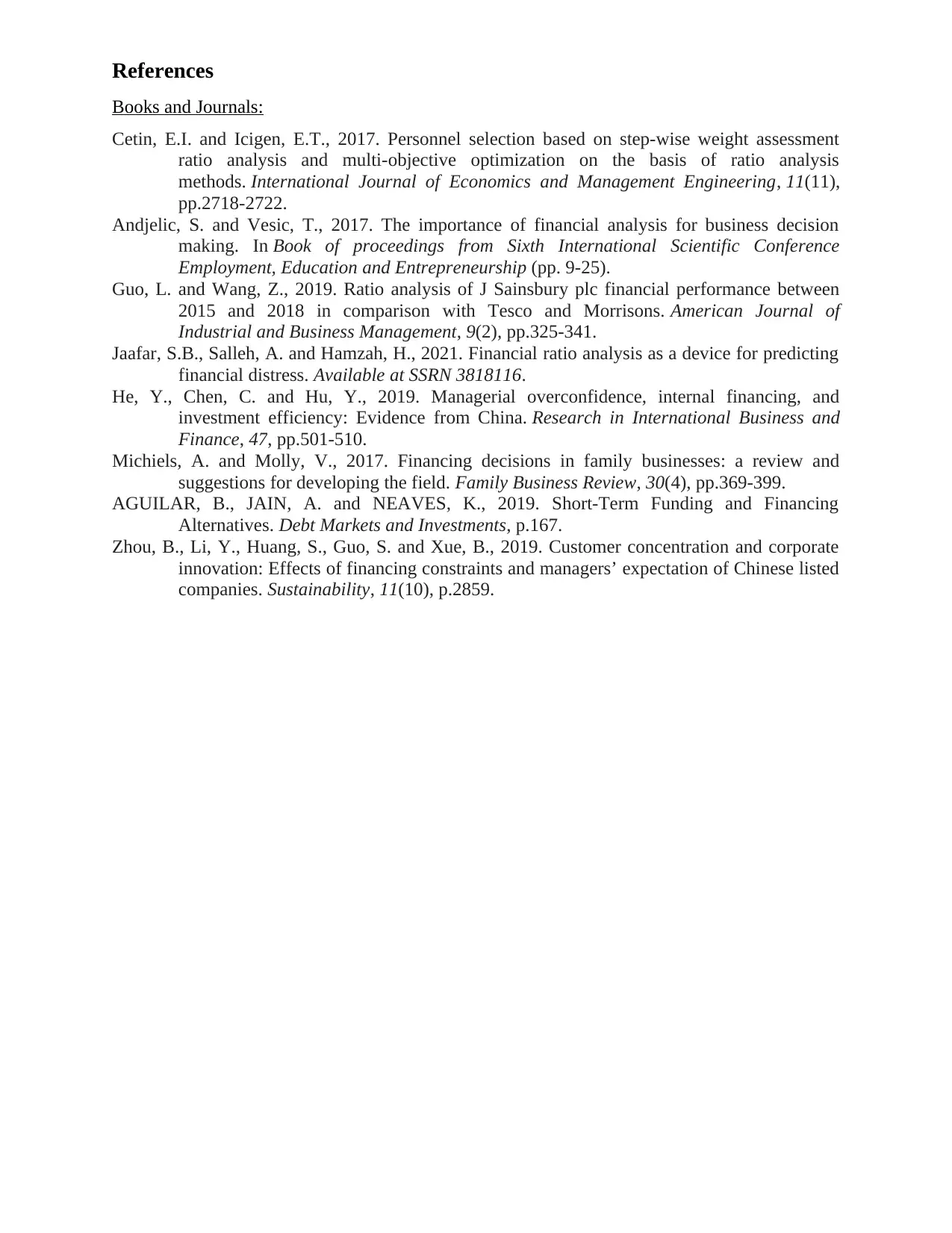
References
Books and Journals:
Cetin, E.I. and Icigen, E.T., 2017. Personnel selection based on step-wise weight assessment
ratio analysis and multi-objective optimization on the basis of ratio analysis
methods. International Journal of Economics and Management Engineering, 11(11),
pp.2718-2722.
Andjelic, S. and Vesic, T., 2017. The importance of financial analysis for business decision
making. In Book of proceedings from Sixth International Scientific Conference
Employment, Education and Entrepreneurship (pp. 9-25).
Guo, L. and Wang, Z., 2019. Ratio analysis of J Sainsbury plc financial performance between
2015 and 2018 in comparison with Tesco and Morrisons. American Journal of
Industrial and Business Management, 9(2), pp.325-341.
Jaafar, S.B., Salleh, A. and Hamzah, H., 2021. Financial ratio analysis as a device for predicting
financial distress. Available at SSRN 3818116.
He, Y., Chen, C. and Hu, Y., 2019. Managerial overconfidence, internal financing, and
investment efficiency: Evidence from China. Research in International Business and
Finance, 47, pp.501-510.
Michiels, A. and Molly, V., 2017. Financing decisions in family businesses: a review and
suggestions for developing the field. Family Business Review, 30(4), pp.369-399.
AGUILAR, B., JAIN, A. and NEAVES, K., 2019. Short-Term Funding and Financing
Alternatives. Debt Markets and Investments, p.167.
Zhou, B., Li, Y., Huang, S., Guo, S. and Xue, B., 2019. Customer concentration and corporate
innovation: Effects of financing constraints and managers’ expectation of Chinese listed
companies. Sustainability, 11(10), p.2859.
Books and Journals:
Cetin, E.I. and Icigen, E.T., 2017. Personnel selection based on step-wise weight assessment
ratio analysis and multi-objective optimization on the basis of ratio analysis
methods. International Journal of Economics and Management Engineering, 11(11),
pp.2718-2722.
Andjelic, S. and Vesic, T., 2017. The importance of financial analysis for business decision
making. In Book of proceedings from Sixth International Scientific Conference
Employment, Education and Entrepreneurship (pp. 9-25).
Guo, L. and Wang, Z., 2019. Ratio analysis of J Sainsbury plc financial performance between
2015 and 2018 in comparison with Tesco and Morrisons. American Journal of
Industrial and Business Management, 9(2), pp.325-341.
Jaafar, S.B., Salleh, A. and Hamzah, H., 2021. Financial ratio analysis as a device for predicting
financial distress. Available at SSRN 3818116.
He, Y., Chen, C. and Hu, Y., 2019. Managerial overconfidence, internal financing, and
investment efficiency: Evidence from China. Research in International Business and
Finance, 47, pp.501-510.
Michiels, A. and Molly, V., 2017. Financing decisions in family businesses: a review and
suggestions for developing the field. Family Business Review, 30(4), pp.369-399.
AGUILAR, B., JAIN, A. and NEAVES, K., 2019. Short-Term Funding and Financing
Alternatives. Debt Markets and Investments, p.167.
Zhou, B., Li, Y., Huang, S., Guo, S. and Xue, B., 2019. Customer concentration and corporate
innovation: Effects of financing constraints and managers’ expectation of Chinese listed
companies. Sustainability, 11(10), p.2859.
1 out of 16
Related Documents
Your All-in-One AI-Powered Toolkit for Academic Success.
+13062052269
info@desklib.com
Available 24*7 on WhatsApp / Email
![[object Object]](/_next/static/media/star-bottom.7253800d.svg)
Unlock your academic potential
© 2024 | Zucol Services PVT LTD | All rights reserved.





